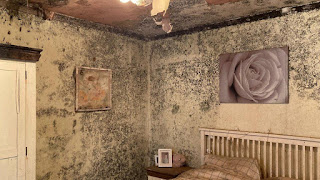With more and more tenants increasingly complaining of mould and damp in rental houses, we could be forgiven for believing the mainstream media that this decline in accommodation standards is due to tight landlord not wanting to improve the conditions their tenants are living in.
But Britain’s cold and damp climate, a result of its position on Europe’s Atlantic edge, naturally leads to rainforest-like conditions.
Despite this, the recent push to retrofit insulation in British homes, which are often criticised for being the coldest and draughtiest in Europe, may ironically worsen living standards.
A BBC investigation highlighted that poorly-fitted cavity wall insulation is causing harmful mould growth in homes.
However, the issue isn’t the insulation failing but rather it working too well.
About 25% of Britain’s housing stock predates 1919, built with traditional methods to manage moisture through airflow.
Air-permeable lime mortar and plaster allowed internal moisture to evaporate, while draughty single-pane windows prevented mould by circulating air. Heating these draughty homes was historically managed by burning large amounts of wood or coal.
Post-WWI, with a loss of skilled tradesmen, builders shifted to using gypsum-based plasters and cement mortar, which are impermeable to moisture.
This led to the introduction of air cavities and vents for circulation. Over time, traditional building skills waned, and older homes were renovated with impermeable materials.
Draughty windows were replaced, and chimneys were closed in favour of central heating, reducing airflow and causing damp issues, which led to ineffective solutions like damp-proof courses and chemical injections.
Now, rising energy costs and climate change concerns are driving another push for retrofitting insulation.
Landlords, believing they were upgrading their rental homes, used government grants for spray foam insulation.
This blocked airflow, leading to moisture buildup, rotting roof structures, and making homes unmortgageable.
Similar problems are arising with foam cavity wall insulation and other retrofits, resulting in wasted taxpayer money and increasingly unliveable homes.
Despite good intentions, the insulation campaign is becoming a scandal, as solutions suited for dry continental climates cause major issues in Britain’s moist environment.
The solution isn’t to demolish and rebuild a quarter of Britain’s housing, but to reinvest in traditional breathable building techniques, turning what is now a niche industry into a widespread practice.
Supporting breathable insulation materials like sheep’s wool would benefit both homes and British farmers.
Additionally, grants for solid fuel-burning stoves could make draughty homes warm and liveable without causing damp and mould.
Often, the simplest, time-tested methods prove to be the best, while well-meaning modern innovations can have unintended negative consequences.

No comments:
Post a Comment